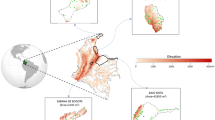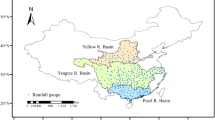Abstract
This study provides some guidance on the choice of predictor variables from both reanalysis products and the third version of the Canadian Coupled Global Climate Model (CGCM3) outputs for regression-based statistical downscaling models (SDMs) for climate change application in southern Québec (Canada). Twenty CGCM3 grid points and four surface observation sites in the study area were employed. Twenty-five deseasonalized predictors and four deseasonalized predictands (daily maximum and minimum temperatures, precipitation occurrence and wet day precipitation amount) were used to investigate correlation coefficients among predictors and to evaluate their predictive ability when used in a multiple linear regression (MLR) downscaling model. The basic statistical characteristics of vorticity at 1,000-, 850- and 500-hPa levels, U-component of velocity at 1,000-hPa level, temperature at 2 m (T 2) and wind direction at 1,000- and 500-hPa level of CGCM3 showed a larger difference with those of the NCEP reanalysis data. Therefore, those seven variables require high caution to be included as predictors in statistical downscaling models. Specific humidity at 1,000-, 850- and 500-hPa levels, geopotential height at 850- and 500-hPa levels and T 2 were the most sensitive predictors for future climate conditions (i.e. A1B and A2 emission scenarios). Specific humidity and geopotential height at different levels and T 2 were important explainable predictors for the daily temperatures. Mean sea level pressure, specific humidity, U and V components and divergence showed potential as predictors for daily precipitation. Spatial explained variance of MLRs between predictors of every different CGCM3 grid points and the four predictands showed large values at the CGCM3 grid points located near the observation sites, whereas relatively small values were shown at the CGCM3 grid points located more than 400 km from the sites. The explained variance of the downscaled predictands by predictors of three or four CGCM3 grid points located near the observation site produced 2–5% larger R-squares than those by predictors of the nearest grid point. The results illustrated that the use of predictors from more than one AOGCM grid points located near the observation site can increase the skill of the MLR downscaling models.












Similar content being viewed by others
Abbreviations
- AOGCM:
-
Atmosphere–Ocean Global Climate Model
- CCCma:
-
Canadian Centre for Climate Modeling and Analysis
- CGCM:
-
Canadian Coupled Global Climate Model
- GP:
-
Grid point
- NCAR:
-
National Center for Atmospheric Research
- NCEP:
-
National Centers for Environmental Prediction
- P amount :
-
Daily precipitation amount
- P occ :
-
Daily precipitation occurrence
- SDM:
-
Statistical downscaling model
- T max :
-
Daily maximum temperature
- T min :
-
Daily minimum temperature
References
Bates BC, Charles SP, Hughes JP (1998) Stochastic downscaling of numerical climate model simulations. Env Mod Soft 13:325–331
Benestad RE (2001) The cause of warming over Norway in the ECHAM4/OPYC3 GHG integration. Int J Climatol 21:371–387
Boer GJ (1995) A hybrid moisture variable suitable for spectral GCMs. Research activities in atmospheric and oceanic modelling. Report No. 21, WMO/TD-No. 665, World Meteorological Organization, Geneva
Busuioc A, Tomozeiu R, Cacciamani C (2008) Statistical downscaling model based on canonical correlation analysis for winter extreme precipitation events in the Emilia–Romagna region. Int J Climatol 28:449–464
Cannon AJ, Whitfield PH (2002) Downscaling recent streamflow conditions in British Columbia, Canada using ensemble neural network models. J Hydrol 259:136–151
Cavazos T, Hewitson BC (2005) Performance of NCEP variables in statistical downscaling of daily precipitation. Clim Res 28:95–107
Charles S, Bates B, Smith I, Hughes J (2004) Statistical downscaling of daily precipitation from observed and modeled atmospheric fields. Hydrol Process 18:1374–1394
Crane RG, Hewitson BC (1998) Doubled CO2 precipitation changes for the Susquehanna basin: down-scaling from the GENESIS general circulation model. Int J Climatol 18:65–76
DAI CGCM3 Predictors (2008) Sets of predictor variables derived from CGCM3 T47 and NCEP/NCAR reanalysis, version 1.1 April 2008, Montreal, 15 pp
Dibike Y, Gachon P, St-Hilaire A, Ouarda T, Nguyen VTV (2008) Uncertainty analysis of statistically downscaled temperature and precipitation regimes in northern Canada. Theor Appl Climatol 91:149–170
Fealy R, Sweeney J (2007) Statistical downscaling of precipitation for a selection of sites in Ireland employing a generalised linear modelling approach. Int J Climatol 27:2083–2094
Flato GM, Boer GJ (2001) Warming asymmetry in climate change simulations. Geophys Res Lett 28:195–198
Fowler HJ, Blenkinsop S, Tebaldi C (2007) Review: linking climate change modeling to impacts studies: recent advances in downscaling techniques for hydrological modeling. Int J Climatol 27:1547–1578
Gachon P, Dibike Y (2007) Temperature change signals in northern Canada: convergence of statistical downscaling results using two driving GCMs. Int J Climatol 27:1623–1641
Gachon P, Laprise R, Zwack P, Saucier FJ (2003) The effects of interactions between surface forcings in the development of a model-simulated polar low in Hudson Bay. Tellus Series A-Dynamic Meteorology and Oceanography 55(1):61–87
Gerardin V, McKenney D (2001) Une classification climatique du Québec à partir de modèles de distribution spatiale de données climatiques mensuelles: Vers une définition des bioclimats du Québec, Contribution du Service de la cartographie écologique. No 60. Ministère de l'environnement, Direction du patrimoine écologique et du développement durable, Québec (in French)
Harding A, Gachon P, Nguyen VTV (2010) Replication of atmospheric oscillations and their patterns in Atmosphere–Ocean Global Climate Model derived predictors. Int J Climatol. doi:10.1002/joc.2191
Hellstrom C, Chen D, Achberger C, Raisanen J (2001) Comparison of climate change scenarios for Sweden based on statistical and dynamical downscaling of monthly precipitation. Clim Res 19:45–55
Helsel RD, Hirsch RM (1992) Statistical methods in water resources. Elsevier Science, New York
Hessami M, Gachon P, Ouarda TBMJ, St-Hilaire A (2008) Automated regression-based statistical downscaling tool. Env Mod Soft 23:813–834
Hewitson BC, Crane RG (1996) Climate downscaling: techniques and applications. Clim Res 7:85–95
Hughes JP, Guttorp P (1994) A class of stochastic models for relating synoptic atmospheric patterns to regional hydrologic phenomena. Water Resour Res 30(5):1535–1546
Huth R (1999) Statistical downscaling in central Europe: evaluation of methods and potential predictors. Clim Res 13:91–101
Huth R (2002) Statistical downscaling of daily temperature in central Europe. J Clim 15(13):1731–1742
Huth R (2004) Sensitivity of local daily temperature change estimates to the selection of downscaling models and predictors. J Clim 17(3):640–652
IPCC (2001) In: Houghton JT, Ding Y, Griggs DJ, Noguer M, van der Linden PJ, Dai X, Maskell K, Johnson CA (eds) Climate change 2001: the scientific basis. Contribution of Working Group I to the Third Assessment Report of the Intergovernmental Panel on Climate Change. Cambridge University Press, Cambridge
IPCC (2007) Climate change 2007: the physical science basis. Contribution of Working Group I to the Fourth Assessment Report of the Intergovernmental Panel on Climate Change (IPCC) Summary for Policymakers. Available from: http://www.ipcc.ch (accessed 10.03.07)
Kalnay E, Kanamitsu M, Kistler R, Collins W, Deaven D, Gandin L, Iredell M, Saha S, White G, Woollen J, Zhu Y, Chelliah M, Ebisuzaki W, Higgins W, Janowiak J, Mo KC, Ropelewski C, Wang J, Leetmaa A, Reynolds R, Jenne R, Joseph D (1996) The NCEP/NCAR 40-year reanalysis project. Bull Amer Meteor Soc 77:437–471
Kistler R, Kalnay E, Collins W, Saha S, White G, Woollen J, Chelliah M, Ebisuzaki W, Kanamitsu M, Kousky V, Dool H, Jenne R, Fiorino M (2001) The NCEP/NCAR 50-year reanalysis. Bull Amer Meteor Soc 82(2):247–267
Linderson ML, Achberger C, Chen D (2004) Statistical downscaling and scenario construction of precipitation in Scania, southern Sweden. Nordic Hydrol 35:261–278
Mekis É, Hogg WD (1999) Rehabilitation and analysis of Canadian daily precipitation time series. Atmos Ocean 37(1):53–85
Murphy J (1999) An evaluation of statistical and dynamical techniques for downscaling local climate. J Clim 12(8):2256–2284
Nakicenovic N, Alcamo J, Davis G, de Vries B, Fenhann J, Gaffin S, Gregory K, Grübler A, Jung TY, Kram T, La Rovere EL, Michaelis L, Mori S, Morita T, Pepper W, Pitcher H, Price L, Riahi K, Roehrl A, Rogner HH, Sankovski A, Schlesinger M, Shukla P, Smith S, Swart R, van Rooijen S, Victor N, Dadi Z (2000): IPCC special report on emissions scenarios. Cambridge University Press, Cambridge, 599 pp
Rummukainen M. 1997. Methods for statistical downscaling of GCM simulations. SWECLIM Rep. 80, SMHI, 29
Schoof JT, Pryor SC, Robeson SM (2007) Downscaling daily maximum and minimum temperatures in the Midwestern USA: a hybrid empirical approach. Int J Climatol 27:439–454
Trigo RM, Palutikof JP (2001) Precipitation scenarios over Iberia: a comparison between direct GCM output and different downscaling techniques. J Clim 14:4422–4446
Tripathi S, Srinivas V, Nanjundiah RS (2006) Downscaling of precipitation for climate change scenarios: a support vector machine approach. J Hydrol 330:621–640
Verseghy DL, McFarlane NA, Lazare M (1993) A Canadian land surface scheme for GCMs. II. Vegetation model and coupled runs. Int J Climatol 13:347–370
Vincent LA, Zhang X, Bonsal BR, Hogg WD (2002) Homogenization of daily temperatures over Canada. J Clim 15:1322–1334
Wilby RL, Wigley TML (2000) Precipitation predictors for downscaling: observed and general circulation model relationships. Int J Climatol 20:641–661
Wilby RL, Hay LE, Leavesley GH (1999) A comparison of downed scaled and raw GCM output: implications for climate change scenarios in the San Juan River basin, Colorado. J Hydrol 225:67–91
Wilby RL, Dawson CW, Barrow EM (2002) SDSM—a decision support tool for the assessment of regional climate change impacts. Env Mod Soft 17:147–159
Wilby RL, Tomlinson OJ, Dawson CW (2003) Multisite simulation of precipitation by conditional resampling. Clim Res 23:183–194
Wilby RL, Charles SP, Zorita E, Timbal B, Whetton P, Mearns LO (2004) Guidelines for use of climate scenarios developed from statistical downscaling methods. Technical report. Data Distribution Centre of the IPCC http://www.ipcc-data.org/guidelines/index.html
Zar JH (1999) Biostatistical analysis, 4th edn. Prentice-Hall, New Jersey, p 423
Zhang GJ, McFarlane NA (1995) Sensitivity of climate simulations to the parameterization of cumulus convection in the CCC-GCM. Atmos Ocean 33:407–446
Acknowledgements
We acknowledge the financial support provided by the National Science and Engineering Research Council (NSERC) of Canada. We are also grateful to Lucie Vincent and to Eva Mekis from Environment Canada for providing observed data sets of homogenized temperatures and rehabilitated precipitation. The authors would like to acknowledge also the Data Access and Integration (DAI; see http://quebec.ccsn.ca/DAI/) team for providing the predictors data and technical support. The DAI data download gateway is made possible through collaboration among the Global Environmental and Climate Change Centre (GEC3), the Adaptation and Impacts Research Section (AIRS) of Environment Canada and the Drought Research Initiative (DRI).
Author information
Authors and Affiliations
Corresponding author
Rights and permissions
About this article
Cite this article
Jeong, D.I., St-Hilaire, A., Ouarda, T.B.M.J. et al. CGCM3 predictors used for daily temperature and precipitation downscaling in Southern Québec, Canada. Theor Appl Climatol 107, 389–406 (2012). https://doi.org/10.1007/s00704-011-0490-0
Received:
Accepted:
Published:
Issue Date:
DOI: https://doi.org/10.1007/s00704-011-0490-0




